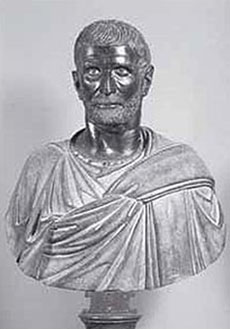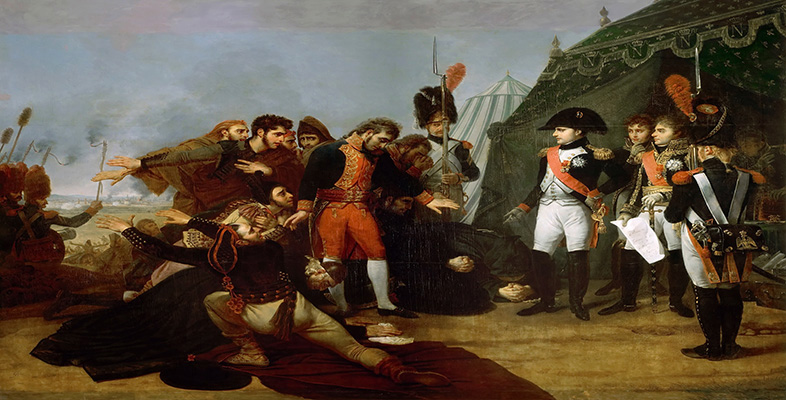2.4 The First Consul
Clickto see plate 11 Antoine-Jean Gros, Bonaparte as First Consul, 1802, oil on canvas, 205 x 127 cm, Musée Nationale de la Légion d’Honneur, Paris. Photo: Bridgeman Art Library
Exercise
Look at Gros's Bonaparte as First Consul of 1802 (see Plate 11 [Tip: hold Ctrl and click a link to open it in a new tab. (Hide tip)] ). How does it differ from the previous portraits of Napoleon we have looked at? What kind of claims does it make on his behalf? Consider the portrait type, setting, pose (including gesture and direction of gaze), costume and accessories.
Note: the uppermost paper on the table is headed by the word traités (treaties) followed by a list of names, concluding with ‘Amiens‘; below this are three further entries, which read ‘18 Brumaire’, ‘Concordat’, ‘Comices de Lyon’. The Treaty of Amiens established a (temporary) peace with England in 1802; the Comices de Lyon was the election of Bonaparte as president of the Cisalpine Republic (northern Italy, effectively) in the same year.
Discussion
This is the first full-length standing portrait we have looked at, and, for the first time, we see Bonaparte in an interior setting, which gives the image a more civilian character than the previous portraits where he is shown first and foremost as a military leader. He is still wearing a uniform and a sword, but the uniform is richly embroidered and seems more ceremonial than functional. At the same time, the plain backdrop counteracts the opulence of his attire and that of the fringed tablecloth, and means that the overall effect is still quite austere. In this respect, it is also significant that his hair is severely short rather than long and flowing as in Gros's previous portrait of Bonaparte. Rather than gesturing commandingly, he points towards the pile of papers on the table; the writing on the top document serves to emphasize not his military victories but rather his achievements as a statesman and a peacemaker. He is not staring out at the viewer but instead looks towards the right and seems to be listening or thinking. The image insists not so much on Napoleon's glorious destiny as on his executive role as head of government and the benefits of his rule.
This portrait established the standard image of Bonaparte as First Consul; it served as the model for several further portraits commissioned from Gros and other artists, usually to hang in public buildings in provincial cities to serve as a focus of loyalty. Prior to 1802, he had continued to be portrayed above all as a military leader (as in David's portrait) rather than in his official capacity. The reason for the delay in establishing the official image for the First Consul was presumably that nobody had any clear idea of what such an image should look like, given that the office had just been invented and was inherently ambiguous. On the one hand, the title of consul was derived from republican Rome while, on the other, the constitution gave the First Consul quasi-monarchical powers. It was during the consulate that Napoleon adopted the antique-style cropped haircut, which was said at the time to make him resemble the Roman consul Brutus, whose appearance was recorded in a famous bust (see Figure 2 ). The flattering (and also hopeful) implication of the comparison was that he, like his ancient predecessor, was a man of integrity, devoted to the good of the republic, and not one to bring about a return to monarchical rule. Gros's painting not only records Bonaparte's new haircut, but also embodies the tensions of the position of First Consul in the way that it tempers official splendour with a certain austerity and in its emphasis on function rather than ceremony, in keeping with the spirit of the Revolution.

